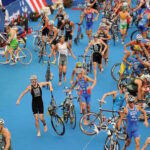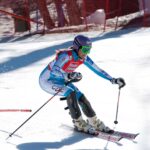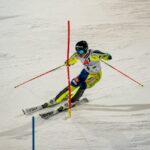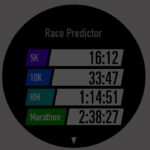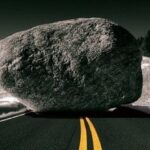“Hi, my name is Jim and I’m obsessed with triathlon.” Yes, I admit it, I am 100%, over-the-top crazy about triathlon.
A brief back story explaining how I arrived at this place of total absorption and immersion in our sport. In the early and mid 2000s, after achieving my goal of running under three hours in a marathon, I transitioned to triathlon and jumped right into and completed two Ironmans and a number of half-Ironmans. In 2008, in the early stages of raising two daughters, I lost my competitive mojo and stopped racing (I continued to bike and run for fun and fitness, but didn’t do a lap in a pool). During the next 11 years, I thought it would be fun to return to triathlon, but that theory never translated into reality. Then, in the summer of 2019, my tri-mojo inexplicably came roaring back. I started training again (though I had no real program), raced four races that summer and fall with some success and hopeful signs for the future, and was excited for the 2020 race season. Then, of course, Covid-19 struck and my triathlon plans were derailed. I did get three races in, but my “A” race, the USAT Age-group Nationals, was cancelled. My passion for triathlon was fueled, rather than dampened, and my enthusiasm turned to obsession (the healthy kind). Since then, I finished 10th in the Sprint and 16th in the Olympic events in Milwaukee in August, 2021 and qualified for several events in Abu Dhabi later this year.
I’m driven by several motivators in my triathlon life. First, the simple satisfaction and joy of pushing myself in training and seeing my efforts translate into performance gains, seeing how fast I can go, and, admittedly, to see how competitive I can be on the national and world triathlon stages. So, in pursuit of eking out every second of speed in a race, I’m constantly looking for things I can buy or do that will make me faster. As a segment on the GCN Tech Show humorously states, “Screw riding up grades; buy upgrades!”
As I concluded 2021 and entered 2022, I began looking for ways to train better and get faster. I have spent countless hours scouring the internet for information that inspires and educates me, and helps me get faster in the three disciplines of triathlon. I have read hundreds of articles and, most significantly, I discovered Global Cycling Network, Global Triathlon Network, and Effortless Swimming, not to mention Lionel Sanders (my motto: If it’s good enough for Lionel, it’s good enough for me!), on YouTube. I’ve been a ravenous triathlete consuming everything triathlon in my path. Being hit by a car last September has only fueled the fire inside of me. As a part of this hunger for all things triathlon, I have accumulated what I call the “12 Really Cool Things for the Obsessed Triathlete in 2022.”
I also don’t want to be tone-deaf to the cost of purchasing all of these “really cool things.” I originally termed these “must haves,” but decided that even if you are deeply passionate about triathlon, you don’t need any of these products or services, and many triathletes can’t afford them. Rather, depending on your psychological investment in triathlon, how lofty your triathlon goals are, how competitive a person you are, how much of a training and gear geek you are, and, of course, the size of your yearly income or retirement portfolio, all of these can be really fun and make you faster as you chase your triathlon goals.
Before I dive in, let me make clear that I was not paid for “endorsing” any of the following products and services. For each “really cool thing,” I introduce many of the best options and also highlight the choices I’ve made because I believe that they are the best out there (though others are welcome to disagree).
Really Cool Thing #1: Power Meter
For the first year and half since my return to triathlon in 2019, I was basically flying by the seat of my pants (as the saying goes) in terms of my training. I tracked my heart rate, but didn’t do anything with the data. I used Rate of Perceived Exertion (RPE) as the only monitor of the intensity of my training. It seemed to work okay, but, because I love training so much, I would often just hammer too much and recover too little, until I was completed cooked and needed to take extra time off.
It became clear from my two summers of triathlon racing that my strength is my running, my weakness is my swimming (I grew up in the “non-drowning” category of swimming), and my cycling was the area in which I could make the most significant gains. It also became clear that I needed a better metric than RPE or HR to guide my cycling training.
I have known about power meters for years, but they seemed so unnecessary and, well, indulgent, that is, until my obsession with triathlon took hold of me. I realized that if I wanted to achieve my triathlon goals, I needed power data to direct my training efforts on the bike as a means of increasing my FTP. So, as is my style, I researched power meters. I learned that there are spider power meters, crank arm power meters, pedal power meters, spindle power meters, power pod power meters, and more. I also learned that they are darned expensive!
After reading many reviews, I learned about the strengths and weaknesses of each type of power meter and their associated brands including 4iii, Favero, Garmin, Stages, Quarq, Powertap, Rotor, and Power2Max. I ended up buying the Quarq DZero for several reasons. First, it has the reputation as the gold standard of power meters. Second, Quarq has been found to be incredibly accurate. Third, it measures power in both legs (as compared to other PMs that only measure one side). Fourth, it doesn’t require buying an entirely new crank. Fifth, Quarq is owned by SRAM which meant easy integration with SRAM etap groupset that I have on both my triathlon bike and road bike. Sixth, Quarq has amazing customer support (Alex M., Alex P., and Jonny are rock stars!). Lastly, the price point was reasonable (as far as power meters go).
Really Cool Thing #2: Sunglasses with Built-in Rearview Mirror
This “really cool thing” for obsessed triathletes is the simplest of the 12 I share with you, yet has had a truly immense impact on my cycling, most notably on my confidence and sense of safety while riding on the road. As every cyclist knows, riding on a busy road can be scary and downright dangerous. More specifically, not being aware of traffic coming from behind and having to turn your head and take your eye off of what is in front of you to see what is happening behind you.
For years, I’ve been looking for a good rearview mirror for cycling, but none that I found met two criteria that would compel me to buy it: 1) It works, meaning I’m able to see a large segment of the road behind me through the mirror, and 2) It doesn’t look geeky (admittedly, I’m a bit of a cycling snob). Of the two most popular styles, bar-end mirrors weren’t effective and clip-on mirrors are so uncool.
Then, back in 2018, I came across Trieye sports eyewear while searching for, well, “really cool things” for cycling that might enhance my cycling experience. I immediately ordered them for several reasons. First, what makes them unique is the rearview mirror is integrated into the lenses. I now literally never look over my shoulder while riding (unfortunately, I wasn’t wearing them when I was hit by that car last September). I can see what’s happening behind me while keeping my eyes looking ahead. Second, they fit comfortably, have high-quality lenses, and actually look good. Trieye clears the bar for both effectiveness and coolness. To be honest, I can’t believe that every serious cyclist or triathlete (and even not serious ones) doesn’t wear Trieye.
Really Cool Thing #3: Smart Swim Goggles
It was only a matter of time before technology spilled over into the pool (pun intended). Unlike while biking or running, there has never been a way to get real-time data while swimming. Instead, we would have to look at the clock on the wall for determining length of swim, interval times, rest times, etc. And I can’t tell you how often I would forget which lap I’m on or how many laps I’ve done.
Then I discovered FORM smart swim goggles. The very first time I used them I knew they were a game changer for me. The in-lenses display shows all kinds of valuable data including lap time, distance, total time and distance, pace, heart rate (when paired with a Polar OH1 or Verity Sense), and much more. No more looking at the wall clock, losing track of laps and distance, or imprecise interval times. FORM also offers 100s of workouts that can be downloaded from the app into the goggles and then appear on the data screen guiding you through workouts. No more cutting and pasting workouts into a document, printing them out, putting them in a Ziploc bag (which always seems to leak for me), and having to look at it constantly throughout the workout. Instead, every aspect of the workout appears on the data screen.
Just as important, particularly given what I do for a living, I find the FORM goggles incredibly motivating. Because I can see my interval times and pace in real-time, I push myself much harder to hit my workout goals.
Really Cool Thing #4: Disc Rear Wheel
Over the last few years in which I’ve re-immersed myself in triathlon, the one piece of equipment that I have coveted most was a disc rear wheel. I had ridden an 85mm rear wheel the first two seasons of my return to our sport, but I experienced wheel envy whenever I saw another age-grouper with a disc rear wheel. Not only does the research show that a rear disc wheel can cut 40s off a 40K bike (compared to a standard rear wheel), but its effect is also psychological; you just look faster and feel faster with a rear disc wheel.
I’m sorry, though, I do have my limits on what I’m willing to spend to satisfy my tri-jones (I still have two daughters to put through college and a well-funded retirement plan would be nice too). And I just can’t justify spending upward of $2500 for a wheel that might save me an extra minute on an Olympic-distance bike course.
I scoured the internet looking for a reasonably priced disc rear wheel. I looked on ebay and the usual cycling-commerce websites for used wheels, but there were no deals to be had and I’m always a little skittish about buying such an essential part of a bike used.
Then I discovered ICAN cycling, a Chinese manufacturer of off-brand bikes and components. And I saw that ICAN makes a TT disc rear wheel for less than $800. Now that I can wrap my arms (and wallet) around!!
I decided to do my research to see if ICAN was legit. ICAN wheels are highly rated on amazon. I found a number of reviews attesting to their quality (here’s a great Youtube video review). And my tri-coach told me that just about all name-brand disc wheels are made in a few factories in China. The dealmaker was learning that some of their wheels are UCI approved, thus attesting to their quality!
Really Cool Thing #5: TT Helmet
Another “really cool thing” I’ve coveted as I have gotten more competitive in our sport is a TT helmet. As with a disc wheel, research shows that a TT helmet can save 30-60s over a 40K bike course. Also, as with a disc wheel, a TT helmet has psychological advantages; you look and feel faster.
There are a lot of great TT helmets out there including the Rudy Project Wing, Giro Aerohead, Smith Podium, Lazer Volante, and Garneau P-09. I chose the POC Cerebel because it was highly rated, had a strong history of protection in alpine ski racing (my primary sport in my youth), and, with its short-tailed design, didn’t make me look like a wannabe pro.
Really Cool Thing #6: Adjustable Saddle
How often do you hear: “I love my saddle!”? Well, I’ve never heard it and I’ve definitely never said it myself. Usually, whether I’m riding my tri-bike or my road bike, the last 10 miles are torture. My back hurts, my hamstrings and gluts are on fire, and, worst of all, my private parts are completely numb (and that’s with a professional fit).
I’ve always wondered how the part of the bike that has the most contact with our bodies can be such a big problem that no one has adequately solved. But I’ve always accepted that the discomfort was just part of the deal when we ride bikes.
Then, this past fall, I was sourcing parts for a new tri-bike that I was building and came across BiSaddle. An adjustable saddle that can be customized to our own unique anatomy. What a no-brainer, I thought, and how did it take so long for someone to think of it. So, I ordered a Stealth for my road bike and a Bonneville for tri-bike and had my bike fitter set me up on them.
On my very first rides, I knew BiSaddle was a game changer. No back pain, no hammies or gluts that needed extinguishing, and best of all, I could tell that my private parts were still down there.
Sure, BiSaddle is a bit more expensive than some saddles, but they’re less than other top saddles. But, OMG, given all the miles I put on my bikes and all of the pain I’ve endured over the years, it was money very well spent.
So, if you don’t want every ride to be a big pain in your you-know-what, go to Bisaddle.com and get one of your own. I promise your backside will thank you every mile of every ride!
Really Cool Thing #7: Supershoes
While cycling is very gear intensive, the other two disciplines in our sport, swimming and running, don’t require a lot of stuff to do. For swimming, a swim suit, goggles, and maybe some training toys, and, now, “really cool thing” #3: FORM Swim Goggles. As far as running goes, even simpler: running shoes. But, over the last few years, new technology in running shoes has changed running for every, most notably, the so-called supershoes that have a carbon plate and Pebax foam. These new materials and construction are considered responsible for the spate of world records over the last few years on the track and on the road. Research has found that these supershoes can be 4%-10% faster than traditional shoes.
Contrary to conventional wisdom, it isn’t the carbon that makes these shoes faster than traditional shoes, but rather the Pebax foam, which is lighter and provides more rebound energy, that is responsible for the increased speed. Though every major running shoe manufacturer makes a carbon-plated supershoe (New Balance, Asics, adidas, Brooks, Hoka, only a few also use the Pebax foam (Nike, Saucony, and Reebok).
I’ve never been a big fan of Nike, so I raced in the Saucony Endorphin Pro in 2021. But, having worn them out, I needed a new pair. My tri-coach, who has a Ph.D. in Exercise Physiology (more on him down below), told me that Nike is the gold standard in terms of speed advantage, so I just bought a pair of Nike Zoom Alphafly Next#.
Really Cool Thing #8: Custom Kit
Okay, I admit that I may be pushing it here, but, well, that’s what I do in all aspects of my life. Let’s be realistic. Most triathletes buy their cycling and tri-kits off the rack or online, not paying too much attention to anything beyond comfort and color. Others are members of a triathlon team or club and proudly wear their kits. I was in both camps early in my triathlon life. But then I heard about custom kits that aren’t any more expensive than quality retail kits.
It used to be that a custom kit was an impossibility for individuals because companies required a crazy high number of orders to justify spending the design time and cost required to produce them. But, thanks to new design and production technology, costs have declined dramatically. Some of the leading purveyors of custom kits include some well-known brands such as Giordana, Louis Garneau, Capo, and Castelli, as well as niche brands such as BioRacer, Rapha, Pactimo, Cuore, and Endura (here’s a good review article).
I decided to go the custom kit route back in 2014 for a few reasons. One, I had been sponsored by PowerBar and rode with their kits for a number of years, but got dropped from their program, so I needed a new kit. Two, I didn’t find any designs that compelling while searching for kits on line nor did I have any strong affiliations with cycling or triathlon products that I wanted to promote. Three, I wanted to provide some professional self-promotion for my sport-psychology consulting practice (though I have to confess that it has never generated any business for me). Lastly, admittedly, my ego thought it would just be fun to have my own kit design.
After doing my usual exhaustive research, I landed on Jakroo for several reasons. First, the quality of their materials were very high. Second, Jakroo had a minimum order of one item. Third, it had a wide range of templates to draw from. Fourth, the turnaround time from design to delivery was only two weeks.
I used Jakroo for the first time in 2014, collaborating with their designers to create a kit around my professional logo. The designers were amazing, creating a design that was “me.” I have ridden and raced with those kits for the last six years. Then, in the fall of 2020, I redesigned my logo and wanted my cycling and triathlon kits to match, so I re-engaged Jakroo. Once again, the collaboration was a huge success and I’m loving my new design.
Really Cool Thing #9: Training Platform
If you’re like me, collecting all of that valuable data is part of the value and fun of the training watches, HR monitors, and power meters. The question that I’ve evolved into an answer for is: Where do I put all that information to gain the maximum benefit? More specifically, which training data platform should I use? There are, of course, many to choose from. Coros, and every other training watch, has it own proprietary platform that not only offers a place to put your data, but also provides analytics and metrics for volume, intensity, fitness gains, recovery, and much more. There are also a variety of stand-alone platforms you can use. I started with Endomondo (I was mostly running then), evolved to Strava, and then, when I got really serious, began to look at the heavy hitters of training platforms including Azum, Today’s Plan, TrainingPeaks, Final Surge, SportTracks, Perfect Pace, and TrainerRoad.
Again, after extensive research and recommendations from several of my clients (I’m a mental coach who works with world-class endurance athletes), I chose TrainingPeaks (TP) for several reasons. First, it was created by Joe Friel, a legendary endurance-sport coach who founded the company more than 20 years ago. Second, TP is widely held as the gold standard among world-class athletes, so if it’s good enough for them, it sure is good enough for me. Third, its analytics are well grounded in the latest sport science. Fourth, it connects and shares training calendars and workout data with just about every other training platform. Fifth, TP was recommended by my new triathlon coach (more on that below). Finally, it is very reasonably priced, particularly given all it offers.
Really Cool Thing #10: Indoor Smart Trainer
I have to admit up front that this is one “really cool thing” that I don’t have and don’t plan on getting any time in the near future. At this point in my triathlon training, a “smart” indoor trainer doesn’t offer me enough value to plunk down the Benjamins that are required to purchase one. I currently use a CycleOps Fluid 2 “dumb” trainer. Though not at all intelligent, my Quarq power meters are smart and allow me to do about 95% of what a smart trainer can do and it meets my indoor training needs more than adequately. Plus, it is lightweight and portable, so I can use it even when I’m not at home.
Nonetheless, I have, given my covetous state, researched indoor smart trainers extensively and there are many quality smart trainers to choose from. In fact, they are all so good that I can’t say which I would buy at this point. Her are the most popular: Wahoo Kickr, Tacx Neo 2T, Elite Directo XR, and Kinetic R1 (here’s a nice review).
Really Cool Thing #11: Virtual Indoor Cycling Platform
This “really cool thing” has been a game changer for every serious triathlete and cyclist. In generations past, riding an indoor trainer meant staring at a wall, watching movies, or listening to music, all insufficient for most of us to dull the raging boredom of literally spinning our wheels and going nowhere.
Oh, how times have changed. The development of virtual-reality technology has allowed a number of virtual indoor cycling platforms to provide riders with an indoor cycling experience that is immersive, engaging, informative, social, competitive, and downright fun to the point that there are some cyclists who would rather ride in their virtual worlds than on the roads and trails of the real world (plus, you can’t get hit by a car in Watopia).
For the past several winters, I’ve been spending most of my time at our cabin in the Sierra Nevada mountains of Northern California (where, in 2019, it snowed 24 feet…in February and, in December of 2021, it snowed 10 feet…in less than a week!). Needless to say, indoor training is a necessity. Two winters ago, before I had the data available from a power meter, I watched a lot of GCN shows and training videos on my laptop during indoor rides, which helped a lot. But it still was pretty darned boring. So, back in November of 2021, I did a “tour” of the best known indoor cycling platforms to see which one was best for me. I did free trials of Zwift, Rouvy, RGT, Trainer Road, The Sufferfest, and FulGaz. All bring unique aspects to the indoor cycling experience including training groups, augmented reality, real rides from around the world, pace partners, group rides, e-racing, cycling data, structured workouts, integration with training platforms, and gamification.
In the end, I chose to sign up for Zwift, not that surprising given that it is the most popular indoor cycling platform out there, for several reasons. First, I found it the easiest to set up and use every time I rode (in contrast, Rouvy required me to download a ride before I could use it with one of my TrainingPeaks workouts). Second, it paired quickly with my power meter, cadence sensor, and HR monitor. Third, the layout of the riding screen was clear and helpful. Fourth, there was a lot to distract me from the boredom or pain of a workout.
Really Cool Thing #12: Tri-coach
Admittedly, the items so far are starting to add up to a pretty hefty outlay, all in the name of feeding an obsession and trying to get incrementally faster. But hiring a triathlon coach has been a huge boon to my training efforts. My self-guided training program was adequate at best, but given my lofty goals for last season and for 2022, I wanted someone who could really direct me on what to do, when to do it, how much to do it, and when to stop doing it. The ultimate goal of which is to prepare me optimally and allow me to become the fastest triathlete I can possibly be. Plus, I wanted a coach who would not only train me, but also satisfy my insatiable curiosity and educate me in the process.
There are, as you may know, innumerable triathlon coaches across the country and around the world, some local and others on the internet. Most of them are experienced and knowledgeable. Yes, they can be expensive, but, if you’re committed to big triathlon goals, a good coach is worth their weight in gold. So, who to choose?
I selected Dr. Greg Rhodes, from Bend, Oregon, whom I had met through my ski racing work, for several reasons. First, Greg holds a Ph.D. in Exercise Physiology, so he clearly knows endurance sports in the deepest and broadest way. Second, he works with several Grand Tour pro cycling teams, meaning if he’s good enough for the pros, he’s good enough for me. Third, Greg is an accomplished triathlete himself, so he also knows the realities of triathlon. Fourth, he doesn’t just cut and paste workouts into TrainingPeaks; rather, he has gotten to know me and has built a training program literally just for me (and we talk at least once a month). Finally, he is a really nice guy who is as passionate about human performance as I am (we can “talk shop” for hours).
Bonus Really Cool Thing: A Superbike
Okay, now I’m REALLY pushing the envelope of “really cool things” for obsessed triathletes. I fully recognize that, if you added up the cost of my first 11 “really cool things,” the price tag would not be insubstantial. I truly don’t mean to substitute “obsessed triathlete” with “wealthy triathlete.” And I also appreciate that not many triathletes can afford every “really cool thing” no matter how obsessed they are. At the same time, if you are truly obsessed with triathlon, as I am, you find ways to buy as many “really cool things” as you can within your triathlon budget.
Which leads me to my final “really cool thing.” There are some truly super triathlon bikes on the market including the S-Works Shiv, Trek Speed Concept, Canyon CFR, BMC Timemachine, Cervalo P5x, Dimond Mogul, Orbea Ordu, Felt IA1, Ventum One, among others. They are all incredibly aerodynamic, sleek, sexy, and fast beasts. They are also all incredibly expensive, with most topping out well above $10,000.
But, as I did my research, I learned that a superbike doesn’t need to be that expensive (though certainly not cheap, by any means). I first learned this lesson back in 2019 when, in approaching a major birthday and not having bought a new road or mountain bike in more than a decade, I decided that I would treat myself to both as a special birthday present. But, though I earn a nice living, I just couldn’t see myself spending $25,000-$30,000 for two superbikes (nor could I explain this outlay to my wife who, though a cyclist too, just doesn’t value bikes in the same way I do). So, I searched on ebay for several weeks and found an 2018 S-Works Venge and a 2018 Trek Top Fuel 9.9 RSL, each with only a few hundred miles on them, for about half the retail price (still not a small sum, but manageable given that they may be the last bikes I ever buy). Three years later, I can’t tell you how thrilled I am with both purchases.
This brings me to my building a new superbike for triathlon over the last few months. As I noted above, I was hit by a car last September on my final training ride the day before the Malibu Triathlon. The bad news was that my beloved tri-bike, a Diamondback Andean (a superbike in its own right), was destroyed. The good news was that I wasn’t (I sustained some pretty serious injuries, but I’m about 95% recovered now and training hard for the 2022 tri-season). The other good news was that my insurance company allowed me to build my dream triathlon bike. I’ve always been partial to UCI-illegal NDD frames (non-double-diamond). In searching for my dream bike, I discovered the Ceepo Shadow, and it was love at first sight. I bought the frameset from Ceepo and then sourced and bought the components on ebay and other online retailers, and then had the bike built by my local shop. The total cost of my new superbike was around half the price of retail.
So there you have it; my list of “really cool things” for obsessed triathletes that can help propel your triathlon efforts to new heights. Yes, ultimately, your passion, determination, and efforts will have the biggest impact on how far you go, but, if you’re like me, wanting to push your limits of how fast and how far you can go in our sport, these “really cool things” might just give you the edge you need to blast your limits into space.
Do you want to take the next step in training your mind to perform your best in training and on race day? Here are four options for you:
- Read my latest mental training book: Train Your Mind for Athletic Success: Mental Preparation to Achieve Your Sports Goals.
- Listen to my Train Your Mind for Athletic Success
- Take a look at myonline mental training courses.
- Schedule a 1:1 session with me.


